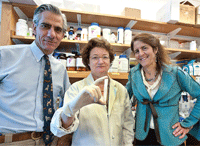In a study at the Children’s Hospital of Philadelphia (CHOP), one course of gene therapy improved the vision of eight children and four adults. The patients had Leber’s congenital amaurosis (LCA), and a single injection of a protein-making gene produced a strong enough result that six of the twelve patients were able to no longer be classified as legally blind. Results were published October in an online article of The Lancet.
“The clinical benefits have persisted for nearly two years since the first subjects were treated with injections of therapeutic genes into their retinas,” says senior author Jean Bennett, M.D., Ph.D., professor of ophthalmology at the University of Pennsylvania School of Medicine.

Dr. Katherine High (center), flanked by Dr. Albert Maguire and Dr. Jean Bennett of Children’s Hospital of Pennsylvania, holds a dose of the RPE65 gene therapy.
Photo: Children’s Hospital of Pennsylvania
Mutations in any one of 13 genes can cause Leber’s congenital amaurosis. The patients in this study have a defect of the RPE65 gene that affects a protein needed for activity of the retinal pigment epithelium. This is the cause of about 6% of LCA cases. Each patient received one injection in the worse eye. Two weeks later, all 12 patients reported improved vision. The gene therapy produced proteins that activate the light receptors in the patients’ retinas—the area impacted by the patients’ LCA.
Objective measurement of pupillary constriction revealed that all subjects’ treated eyes were able to detect significantly more light than their untreated eyes. And, nine eyes with nystagmus secondary to LCA demonstrated significant improvement.
The researchers hypothesized that treatment would be age-dependent because damage to the retina progresses with age. So, the patient cohort ranged in age from eight to 44 years. As predicted, results in younger eyes showed a more marked improvement, although the children did not attain normal eyesight.
“Children who were treated with gene therapy are now able to walk and play just like any normally-sighted child,” says co-first author Albert M. Maguire, M.D., associate professor of ophthalmology at the University of Pennsylvania and a physician at CHOP. “They can also carry out classroom activities without visual aids.”
Researchers captured patients’ progress on video, monitoring visual progression by requiring patients to traverse a standardized obstacle course. Prior to treatment, this was very difficult; after treatment, however, the children were able to more easily navigate the course. Not all of the adult patients performed better.
Researchers hope to monitor patients’ retinal degeneration to see if the gene therapy treatment stopped it completely or slowed it. “In the future, we hope to investigate whether other retinal disease will be amenable to this gene therapy approach,” says Dr. Maguire.
Maguire AM, High KA, Auricchio A, et al. Age-dependent effects of RPE65 gene therapy for Leber’s congenital amaurosis: a phase 1 dose-escalation trial. Lancet. 2009 October 24; [e-pub before print].

